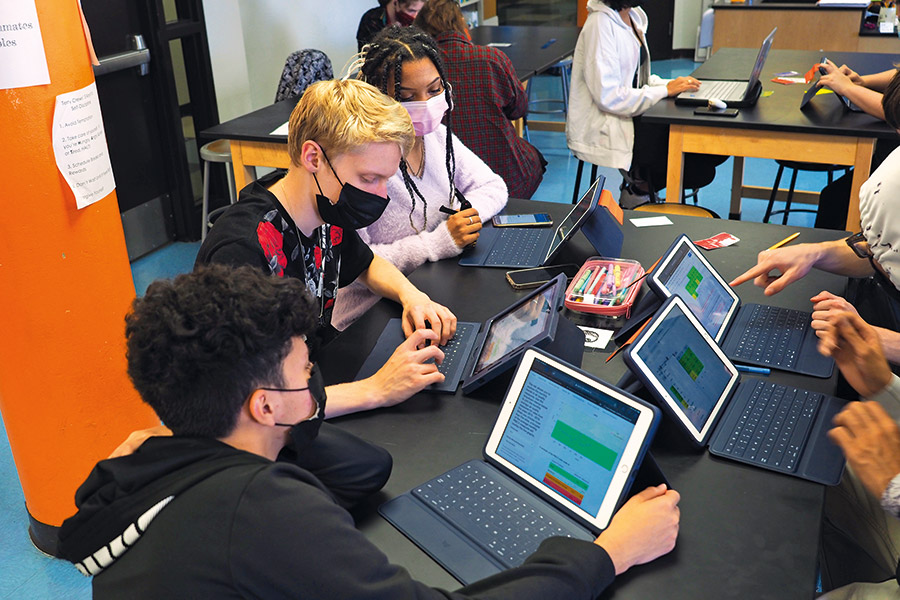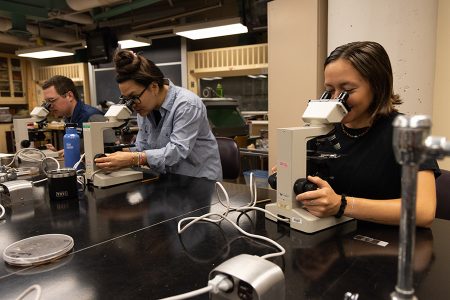Through a partnership between the SPH Division of Biostatistics and the St. Paul Public Schools, ninth grade students will be exposed to data science via an interactive (and dare-we-say-fun) curriculum.

Biostatistics can be intimidating, with its allusion to exacting mathematics and sophisticated science. But overcome the intimidation factor and there lies a fascinating field with broad appeal.
Getting to this sweet spot by introducing biostatistics to ninth-grade students is one of the goals of a new partnership between the School of Public Health Division of Biostatistics outreach program and St. Paul Public Schools (SPPS). The partnership is exposing students to data science, environmental health science, and public health in general through a co-created curriculum.
Sarah Samorodnitsky, biostatistics PhD student, kicked off the division’s outreach efforts with this first SPPS project. Her hope is that by introducing biostatistics at the high school level, it will demystify the subject and offer new pathways to public health careers, especially for students that historically haven’t been exposed to these opportunities. The partnership came at a perfect time.
“It’s empowering for young people to understand what data means and how it impacts them.”
Sarah Samorodnitsky
“SPPS went through a strategic planning process and one of their priorities is career and college readiness,” says Marta Shore, outreach committee chair and instructor in the Division of Biostatistics. “We could satisfy that priority for students. Additionally, working with us was appealing because, with our help, SPPS could meet new state standards for ninth grade science classes to be more data-driven rather than completely textbook-driven.”
The outreach committee brainstormed what that data-driven approach might look like and presented their ideas to SPPS teachers in the spring of 2020. The teachers chose a curriculum that would allow students to study real-world public health scenarios involving air quality and the environment. An interactive site showcasing Minnesota’s air quality levels over the last five years would accompany the curriculum, providing students with a platform to engage with the data.

“We knew that whatever we created had to be something that students could understand in the context of their own lives,” Shore says. “It had to be local and current in order for it to be relevant.”
Biostatistics PhD student Rachel Zilinskas led the efforts in developing the site.
“We downloaded all the raw data back to 2015, which was publicly available at the Minnesota Pollution Agency,” says Zilinskas. “There are different tabs on the site that have different analyses you can run. We cleaned the data and each of us was responsible for developing a tab
in the app.”
The result is a robust map of Minnesota that allows students to explore air quality throughout the state during different date ranges and other criteria. Tabs let students explore such things as how human activities impact air quality, or air quality trends depending on the season, the weather, or even holidays.
This fall, all 10 high schools within the SPPS system will apply the biostatistics curriculum. One of them is Creative Arts Secondary School.
“Before I was a teacher, I was a scientist,” says Ross Winberg, science teacher at the school. “So I like the fact that, with this curriculum, we’re pulling in real data and looking at a problem that’s relevant to us all.”
Winberg shares an example of a possible assignment using the application. Students would begin by reading a news article about Canadian wildfires in the summer of 2018, then he’d challenge them to investigate how air quality in Minnesota was affected during that time.
“This is called ‘claim, evidence, reasoning,’” Winberg says. “We make the claim that these Canadian wildfires affected the air quality. Then students would have to search for evidence to support that claim and do some reasoning to explain the connection.”
Students will solve air-quality mysteries like this, drawing on clues in the data that the biostatistics outreach committee planted for them. By stoking curiosity and introducing students to public health data in an interactive format, the curriculum will support a complex-thinking model while introducing kids to biostatistics in a way that’s fun and interesting, not intimidating and scary.
“It’s empowering for young people to understand what data means and how it impacts them,” Samorodnitsky says. “This is where biostatistics comes in — doing that research and explaining it clearly. It’s good for young people to feel empowered by that knowledge.”
“The chance to be exposed to these things at an earlier age to build confidence is huge,” adds Zilinskas, reflecting on the potential of the ninth-grade science curriculum. “They might be inspired to go into a career they didn’t originally think they could pursue.”


